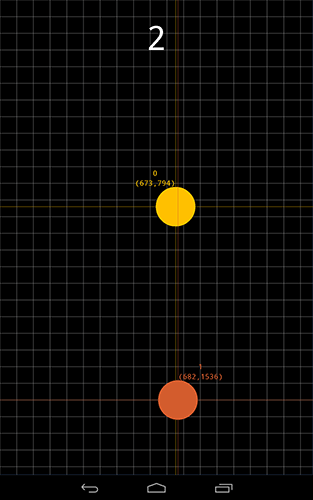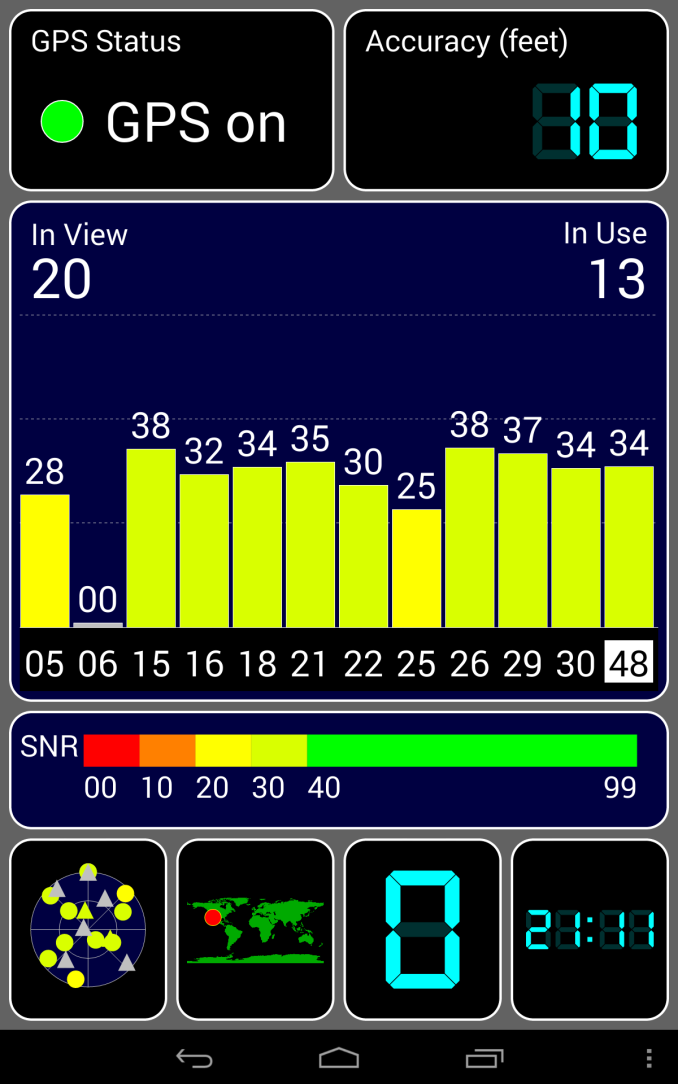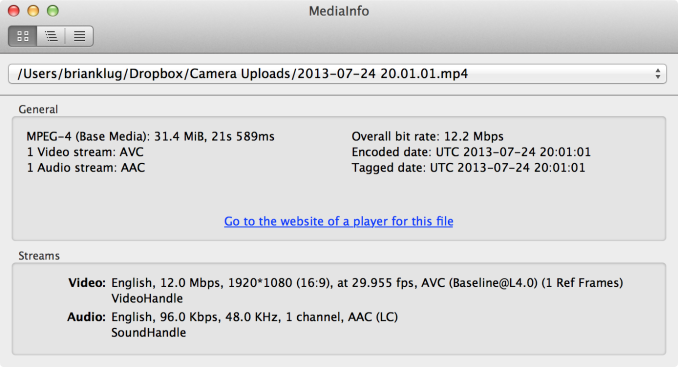The Nexus 7 (2013) Review
by Anand Lal Shimpi on August 22, 2013 6:00 PM ESTWiFi, GPS
I won't spend too much time on either of these points as Brian already did so in his initial review. WiFi duties are handled by Qualcomm's WCN3660 WiFi combo chip. The new Nexus 7 sees an update to include 5GHz 802.11n support, which is a very welcome addition. There's no 802.11ac, understandably for cost reasons. 802.11ac is probably the only thing missing from this otherwise awesome platform.

When it comes to GPS, there's good news and bad news. The good news is that Qualcomm's GNSS implementation remains the fastest we've tested as far as time to lock is concerned. The bad news is there seems to be an issue with the Nexus 7's impementation, likely in software, that results in the tablet randomly losing GPS lock. Update: It looks like this has been fixed!

Note that neither my Nexus 7 nor Brian's have exhibited the instability or consistent reboots that I've seen reports of. I had a single unexpected reboot during my GPS testing but that was it. Brian's sample has been running with over 22 days of constant uptime at this point. I also haven't seen any multitouch issues on my Nexus 7, although touch controllers are sometimes sourced from multiple vendors which could explain some of the issues others are seeing. Update: Looks like this one is fixed too!
Camera
The new Nexus 7 adds a 5MP rear facing camera, something its predecessor didn't have at all. While I rarely use my tablet for taking photos, I will admit the absence of a rear facing camera on the old Nexus 7 caught me off guard. Image quality out of the rear camera is decent. I threw together a gallery comparing the Nexus 7's rear camera to the iPad mini, MeMO Pad HD7 and Galaxy Tab 3 8.0:
In well lit situations and if you're sharing photos at lower resolutions, the Nexus 7's camera isn't bad at all. It's not the best thing in the world but in a pinch it's fine. I also threw in iPhone 5 samples as a reference in the gallery above.
Video on the Nexus 7 (2013) is 1080p30 at 12 Mbps, H.264 Baseline with 1 reference frame, and 96 kbps 48 KHz single channel AAC audio.


















202 Comments
View All Comments
coldpower27 - Thursday, August 22, 2013 - link
Though bare in mind iPad mini is an old device due for a refresh in the Fall. A Retina display version, with a lower power A6X chip would do wonders. Unless you really love iOS, and the features Apple gives with their product, spec wise the Android tablet has them beat. But specs has never been all that is important when it came to these products. User experience is still key.looper - Thursday, August 22, 2013 - link
Coldpower27, I agree. Imagine the cost of a possible upcoming iPad Mini w/ Retina display.I wonder how much bigger one can make the default font size on the new Nexus7. My eyesight is not the best.
Oh, BTW, the word is "bear", not "bare"; and "specs *have* never been", not "has never been"... sorry.
mmarafie - Friday, August 23, 2013 - link
Yes of course :) When the new iPad mini is released that's when you'll see the Anand compare directly with the Nexus 7, and talk about how amazing the CPU/GPU in the mini are while again omitting mention of the price difference (probably double the cost of the N7) or any other strengths the N7 might have (higher ppi, more RAM, faster CPU etc).I'm still waiting for the review of the Nexus 10 which got released last year around the same time as iPad 4 (I own both), and the iPad 4 got the review in December while the Nexus 10 just got a preview.
weiran - Friday, August 23, 2013 - link
> any other strengths the N7 might have (higher ppi, more RAM, faster CPU etc).If a Retina iPad mini is released, it will have a higher PPI than this N7. And we all know that comparing specs in tablets is pointless if the comparison involves different OSes.
mmarafie - Friday, August 23, 2013 - link
Well define Retina please? If I'm not mistaken Apple considers 300 ppi and higher displays as Retina, yet the iPad 4 only has a 264 ppi display. The new Nexus 7 is over the 300 ppi magic number at 323. For the iPad mini to have a higher ppi than that it will need a higher resolution screen than the full HD one of the N7. It will need the same resolution as the iPad 4 (2048x1536) or higher. Its possible the new iPad mini will be released with a high res screen so we'll have to wait and see.kascollet - Saturday, August 24, 2013 - link
Retina is an Apple world, they can put it on whatever device they want but it always means :- pixels not visible at usual distance (more than 300 for a phone, more than 200 for a laptop, I between for a tablet...)
- high res is obtained by quadrupling the pixel count and thus conserving screen ratio and graphical elements size (makes all apps immediately compliant).
So if a Retina iPad Mini is made, it WILL feature a 2K x 1.5K resolution like the iPad 4.
retrospooty - Saturday, August 24, 2013 - link
"Retina is an Apple world, they can put it on whatever device they want but it always means :- pixels not visible at usual distance "
With a disclaimer - for 20/20 vision... Which is average eyesight, not above and not at all amongst the best. Most people with better eyesight may out around 400-450 DPI at 12 inches - some even higher.
Fri13 - Thursday, November 14, 2013 - link
20/20 is for normal eye sight, and it is the for most people.For most people (<90%) the 300 DPI at 20cm distance is more than enough, they can not see differences between that and 150 DPI without using magnification glass (lope actually) and compare exactly same content. With PPI there is no difference either unless you start looking trough very small details like in fonts from distance of 5-10cm and it isn't good for your eyes anyways. At normal viewing distance with tablet is 35-40cm.
When it comes to very good eye sight, last time what I read about the record (over decade ago) it was that a person could detect 6mm long string from distance of 2km, would be like display should have so high resolution that its density would be over 1.5 million on inch. But not even then a person with great eye sight could care less does display have a 150 PPI or 300 PPI.
I had once a friend and her eye sight was very good, she could read a normal news paper font (10-11 points) from distance of 20 meters. You couldn't not believe it without being there testing it. It was just jaw dropping that you could take any page and present it to her from 20m distance and she could read it a loud (we didn't test longer distance). But it was amazing how she could read a traffic signs text from few kilometer distance. It was like having a hawk what can talk to you.
The most important part in display pixel density is that font is rendered in manner it is clear to read. So you don't mistake letters and you don't need to spend much time quessing what letter is what.
Like how many is whining about 72-90 PPI in their workstation/laptop displays? They can read it perfectly fine, they don't find them disturbing to have much lower pixel density in their much bigger computer screen, but then they whine about smartphones and tablets if it is below 300 PPI.
retrospooty - Saturday, August 24, 2013 - link
"Well define Retina please?" - Retina is a marketing name Apple came up with for higher res screens. Apple fans, being a mostly non-technical bunch think it means something, but its arbitrary specs are just that... Arbitrary. 330+ isnt the end all be all of the DPI usefullness. The average eye cannot detect pixels at much higher DPI, but the other 1/2 of the world with above average eyesight can. IF you can see pixels, the higher hte better. If you cannot, save your $$$ and get something cheaper.abazigal - Saturday, August 24, 2013 - link
Retina is actually a combination of both PPI and distance of the screen from your eyes.Apple would probably explain that since users tend to hold the ipad further away from their eyes compared to a smartphone, the ipad4 can still be considered retina despite its lower PPI.
The ipad mini will likely have the same 2048x1536 display to maintain backwards compatibility with existing ipad apps. That gives it a PPI of 324 (same as iphone), putting it on par with the Nexus7.
My, hardware certainly has come a long way.